PART 2 – COLLECTING AND DISPLAY
In this second blog, Dr Andrew Hillier explores how the International Exhibition in Paris (1900) provided this young Customs man with the opportunity to collect local costumes in Yunnan but how their acquisition and display raises further questions about imperial activity in China’s borderland areas.[i]
In Search of Costumes
Having developed at least some understanding of the people to the south of Szemao (also spelled Semao or Ssu-mao, now Simao), in March 1899, Carey set off once again, this time ‘striking south-west, through a region never before traversed by Europeans, along a road followed by cotton caravans coming up from Bulma’.[ii] Travelling without ‘a comrade’, his caravan comprised seven pack-animals with two muleteers, a servant, a coolie who carried his ‘snap-shot camera’, and a soldier – ‘a picked man from the Prefect’s Yamen’ to whom he entrusted his shot-gun.
The main purpose of this more extensive expedition was to gather ‘as much interesting material as possible’ for the International Exhibition due to be held in Paris the following year. Although, as on previous occasions, Sir Robert Hart (the Inspector-General of the Chinese Maritime Customs) played a part, the Zongli Yamen (roughly, the equivalent of a Ministry of Foreign Affairs), appointed a French diplomat, C.E. Vapereau as Commisaire-Général to oversee its organisation.[iii] Whilst the expedition provided Carey with the opportunity to put his knowledge of Yunnan’s diverse cultures to good effect, it also raises questions as to whether this was a further exercise of imperial power, particularly given the methods he used to obtain the items.
Almost immediately, he was negotiating to purchase ‘the pretty costume of the “Hua Yao Pa I” women’ but, as he explained in his RGS paper, he had to do so ‘without exciting suspicion as to [his] motives’, as they did not want them to be removed from the village.
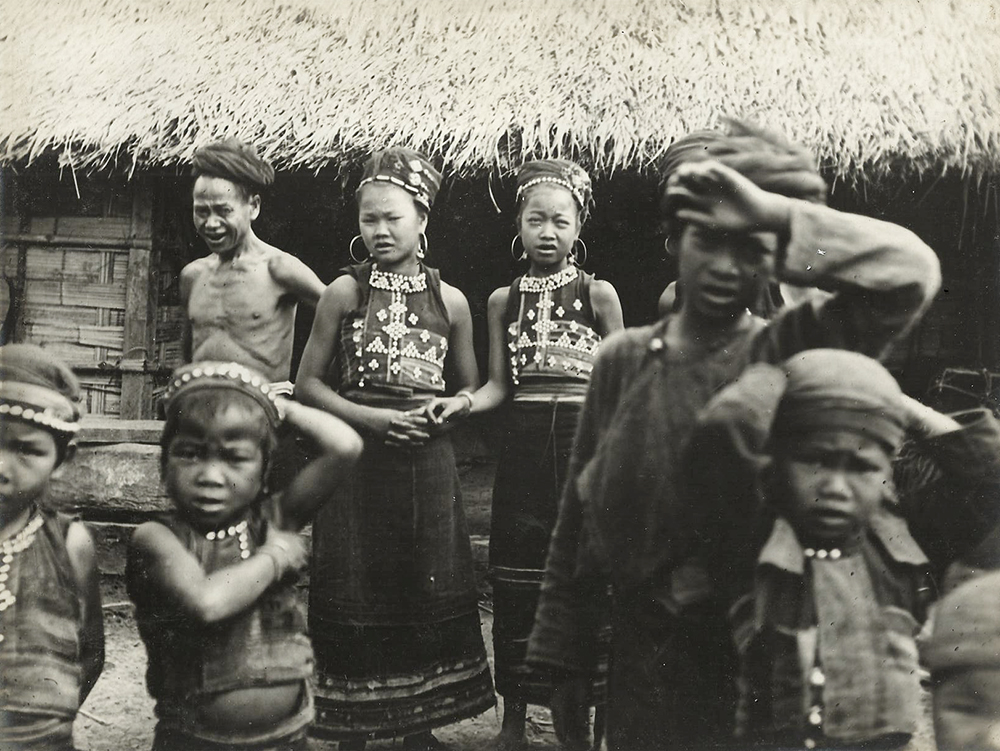
The ‘pretty costume’ of Hua Yao Shans, exhibited in Paris at the International Exhibition. Frederic Carey Collection, FC01-26 © 2011 Ann Kinross.
Arriving in Panang, he was keen to buy a costume belonging to the Akka women, which included an elaborate head-dress. Again, they were reluctant to part with it because it was vested with religious beliefs but, eventually, the headman relented. The next morning, ‘followed by a crowd of villagers, [he] appeared, bringing a complete dress with the hat’, telling Carey that nearly all the women in the village had been engaged in making it over-night.
A similar request a few days later in the Kawa region was rebuffed, but he struck lucky in the market at Meng Lien, where he ‘obtained several curiosities, including the gala dresses of the Kawa and Lohei women’ and purchased ‘without difficulty’ another of the Shan costumes, ‘trimmed with silver and elaborately embroidered’. As before, he covered an extraordinary distance, taking short cuts which were too steep for the mules, snapping pictures as he went and compiling notes and short vocabularies of key words of the various languages he came across. After thirty-three days, he was back at the Customs House, boasting a large collection of items.
The International Exhibition
These had to be transported, first by mule and then by river to Shanghai, for onward shipment to Paris. The catalogue for the China Pavilion lists seventeen items of tribal clothing as coming from the area around Szemao, most of which presumably emanated from Carey’s efforts. They are identified simply by reference to the name of the particular tribe – for example, costumes de femme Shan: tribu Lu: Ētats Shans Chinois – and without any ethnographic explanation or context, save in the case of the Kawa, where a distinction is drawn between tribu civilisée and tribu sauvage.[iv] Participation in previous exhibitions had been opposed by the Chinese elite, because they had no say in the selection of the items to be displayed, many of which were chosen (principally by the CMC) with an emphasis on their ‘primitive’ aspects. However, the Paris exhibition was different. As we have seen, Vapereau had been appointed by the Chinese government, and this was with a view to displaying the progressive aspects of the country’s industry and culture. [v]
If there was a problem, it was in the lack of any explanation in the catalogue in relation to the items that were displayed. Divorced from their context and deprived of their spiritual or ‘superstitious’ significance, these emblems of tribal identity lost their original meaning, but it is unclear how they were perceived by visitors to the Pavilion and what new meaning they may have acquired.
![The costume worn by the ‘Pa-I’ or ‘coloured bodice’ Shans and exhibited in Paris, consisting ‘of a turban embroidered with gold thread, a short tight-sleeved jacket, a long white petticoat, and a coloured skirt’. In the RGS article, the photograph is captioned, ‘Pa-I’ Shans Playing at the love-game of throwing coloured balls’, Carey adding that he was ‘pelted with the love-missiles whenever[he] appeared in the valley. Frederic Carey Collection, FC01-08 © 2011 Ann Kinross.](https://hpchina.blogs.bristol.ac.uk/files/2018/04/FC01-08.jpg)
The costume worn by the ‘Pa-I’ or ‘coloured bodice’ Shans and exhibited in Paris, consisting ‘of a turban embroidered with gold thread, a short tight-sleeved jacket, a long white petticoat, and a coloured skirt’. In the RGS article, the photograph is captioned, ‘Pa-I’ Shans Playing at the love-game of throwing coloured balls’, Carey adding that he was ‘pelted with the love-missiles whenever[he] appeared in the valley. Frederic Carey Collection, FC01-08 © 2011 Ann Kinross.
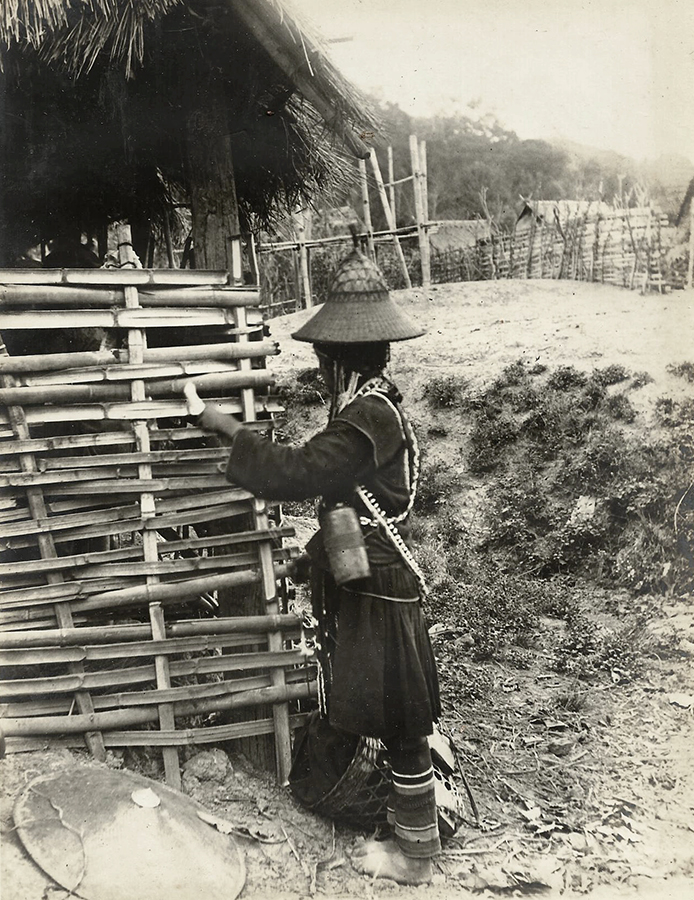
Akk’a woman, Shan States. Another of the costumes exhibited in Paris. Frederic Carey Collection, FC01-02 © 2011 Ann Kinross.
Whilst press coverage of the exhibits seems to have been limited, the traditional Chinese buildings were praised, even if it was the French who received the plaudits, one review stating that ‘la section Chinoise etait admirablement presentée par M. Ch. Vapereau’.[vi]
![‘Le Palais Chinois’ from "Le Panorama: Exposition Universelle [de] 1900" (Paris: 1900). Note the depiction of ‘Chinese visitors’. (Image courtesy of University of Bristol Library, Special Collections).](https://hpchina.blogs.bristol.ac.uk/files/2018/04/SC003391.jpg)
‘Le Palais Chinois’ from Le Panorama: Exposition Universelle [de] 1900 (Paris: Librairie d’Art, 1900). Note the depiction of ‘Chinese visitors’. Image courtesy of University of Bristol Library, Special Collections.
An Abiding Interest
Worrying though the events of the Uprising were, they did not diminish Carey’s interest in the region and its peoples. He continued to travel extensively, photographing festivals, funerals and exotic female ‘fashions’.
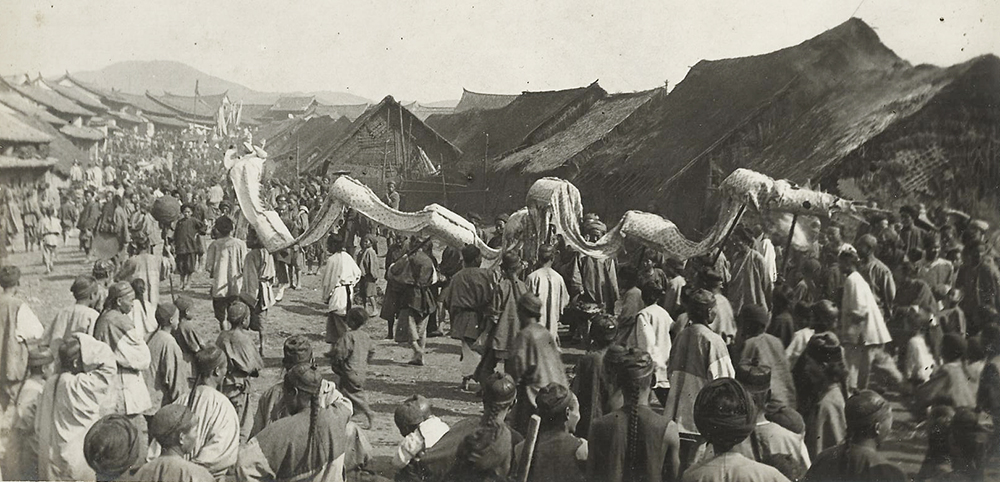
‘The delight of the small boys … is the Dragon, a fearful animal, wonderfully made with wicker basket work and coloured cloth. Each of the vertebra …is supported by a man’. Frederic Carey Collection, FC01-24 © 2011 Ann Kinross.
Carey was also interested in simple agricultural implements, such as a water- wheel for irrigating the fields and an ingenious ‘labour-saving device’ for skinning rice, both of which he displayed in the lantern slides that illustrated his talks.
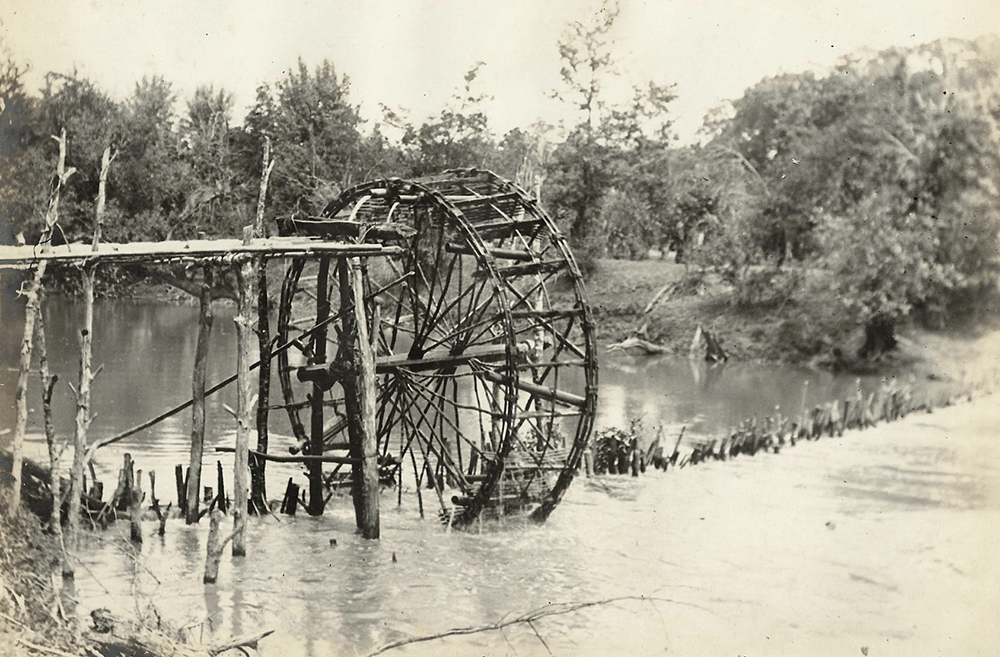
A Shan water-wheel used to irrigate the fields. Frederic Carey Collection, FC01-16 © 2011 Ann Kinross.
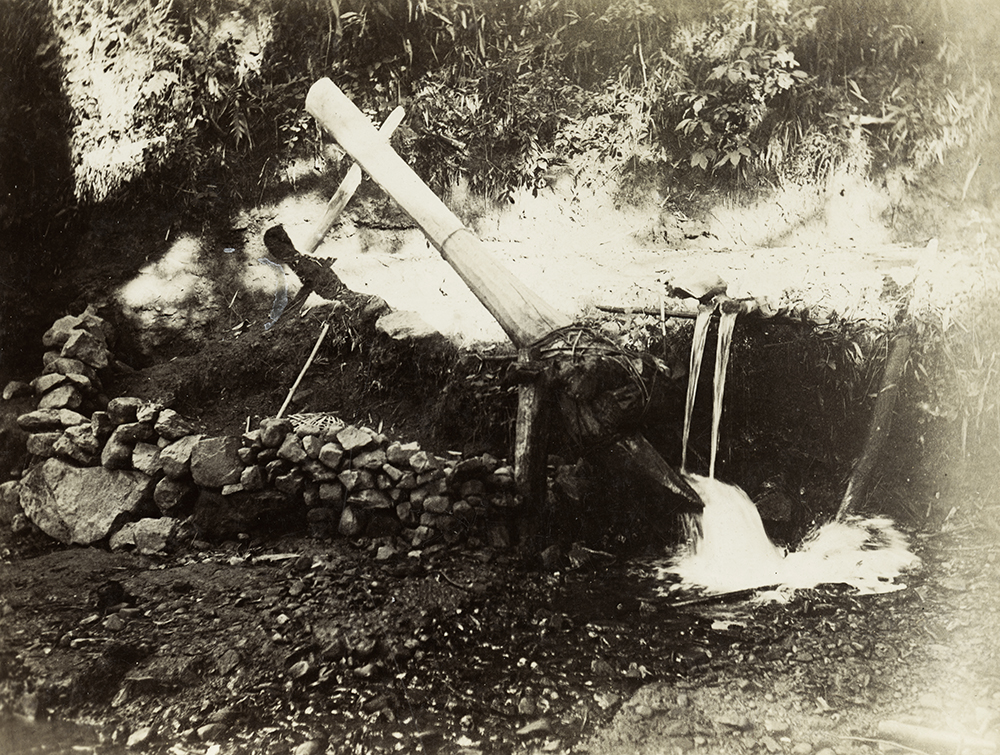
A rice-skinner: ‘… a wooden log, hollowed at one end, and with a piece of hard wood fastened through the other. The log is evenly balanced and a stream of water is directed onto the hollow end, which sinks down under the weight of water, empties itself and rises again. The other end falls continually onto the grain and loosens the husk’. © Royal Geographical Society (with IBG).
After a slow start, Carey’s career was beginning to progress. In 1900, he was appointed Assistant-in-Charge and, because no consular official was prepared to serve at Szemao, he enjoyed the unique distinction of being temporarily appointed the treaty port’s consul. Even in this remote area, it was, in his words, an ‘exceptionally critical and dangerous’ time, and one in which he ‘succeeded in upholding British prestige’.[viii] In December 1901, Carey began his first period of furlough and, whilst in England, he delivered his paper to the Camera Club.[ix] Compared to the RGS, this was a very different audience, one which would not have had the same ethnographic interest nor have necessarily subscribed to the imperial ethos inherent in the exercise. The content of the paper, however, was similar and, at a time when demonization of China was coming into vogue, the tone is relatively free of imperial condescension.
On his return, he was appointed Acting Commissioner at Sanduao, a small port in Fujian. It would be another sixteen years before he achieved his first full appointment at Ningbo. Heavily involved as co-chairman of the Chinese-Foreign Famine Relief Committee, on leaving, he was hailed as the city’s ‘best-loved Commissioner’.[x] Transferred to Swatow in 1925, Carey retired two years later. Sadly losing much of his money in what turned out to be a fraudulent investment scheme, he returned to China to work for the Fairey Aviation Company and died after a short illness in Shanghai in January 1931.[xi]
Apart from the odd snippet of information, we know little of his life after he left Szemao. It is clear from his talks, including one he gave on the BBC radio in 1922, that he never lost his fascination for the region and its people, but, although he served as Assistant Commissioner at Tengyueh (Tengchong), Yunnan, from 1909 to 1911, he does not seem to have taken any further photographs, another puzzle in the life of this enigmatic Customs man.
On one view, Carey was a typical late Victorian explorer, seeking and recording archaic peoples before they became extinct and gathering information to further Britain’s empire project. If photography was one way of asserting power over these people, collecting and displaying their costumes at an International Exhibition was its logical extension. However, with its complex ethnic mix, the borderland of Yunnan had its own special characteristics and was a region where the Qing was still powerful. Whatever view is taken of Carey’s methods, not least the concealment of his intentions when taking photographs and collecting costumes, he had a genuine interest in these people, who were so very different from the Chinese, and the preservation of their identities. Far from wanting ‘to insinuate alien forms of practice into their everyday life’, he believed that their culture needed to be respected and preserved. But that was not because, applying Darwinian principles, he saw it as evidence of ‘primitive man’. On the contrary, he saw it as vibrant and existing in its own right but in danger of being absorbed and hybridised by the rapidly- expanding Chinese population and of losing its own ‘geographic imaginary’. The problem was that one of the main threats to their identity stemmed from the demarcation and imposition of new borders in Yunnan, an exercise in which the Chinese, British and French were all engaged.[xii]
Where to draw the line between what was acceptable scientific inquiry and racial condescension will always be problematic. As Sadiah Qureshi has emphasised, this was ‘a period when who could be a legitimate contributor to the making of natural knowledge and what counted as science were being re-forged’ and recognising this ‘pliable disciplinary landscape’ allows for a better understanding of ethnological and anthropological practice at this time. This, I suggest, is the context in which we should look at Carey’s explorations and the work he carried out.[xiii]
Much of Carey’s life remains a puzzle, not least, why he first joined the CMC only as a member of the Outdoor Staff. Moreover, for all his ethnographic interest, there remains the question of how this apparently gregarious young man should have not only survived but, seemingly, relished his four years in such a remote out-port. It is a truism that travel is a form of self-discovery and it may be that, in seeking to understand these alien cultures, he found a way of understanding himself.[xiv] If so, this may explain why he then stopped taking photographs. When he left Yunnan, he may have decided he no longer needed his camera.
[i] For the first blog, see http://visualisingchina.net/blog/2018/03/29/with-a-camera-in-yunnan-the-ethnographic-expeditions-of-frederic-w-carey-rgs/.
[ii] See the map in the first blog. Save where otherwise stated, quotations are from the paper read on his behalf to the Royal Geographical Society, ‘Journeys in the Chinese Shan States’ The Geographical Journal (15) May, 1900, pp. 486-515.
[iii] Hart later acknowledged that Vapereau made ‘an excellent job’ of planning the China Pavilion and its display, Hart to Campbell, 4 October 1896 (1038), Fairbank, The I.G. in Peking.
[iv] Chine: Catalogue Special des Objets Exposes dans La Section Chinoise à L’Exposition Universelle de Paris, 1900 (Paris: Charles Noblet et Fils, 1900), p.104 and see also pp. 91 and 133: https://archive.org/stream/chinecataloguesp00unse#page/100/mode/2up/search/szemao
[v] Hyungju Hur, ‘Staging Modern Statehood: World Exhibitions and the Rhetoric of Publishing in Late Qing China, 1851-1910’, Unpublished PhD Dissertation, University of Illinois at Urbana-Champaign, (2012), pp. 2-7 and 11-35, especially, p.34.
[vi] Exposition Universelle Internationale de 1900 à Paris: Rapport général administratif et technique, Vol. 5, (Paris: 1902), pp. 48-49, which also includes photographs of the China Pavilions. https://archive.org/stream/expositionuniver05expo#page/48/mode/2up/search/chinoise The China Pavilion is not mentioned in Richard D. Mandell, Paris 1900: The Great World’s Fair (Toronto: University of Toronto Press, 1967).
[vii] Robert A. Stafford, ‘Scientific Exploration and Empire’ in Andrew Porter (ed.), The Oxford History of the British Empire, iii. The Nineteenth Century (Oxford: Oxford University Press, 1999), pp. 294-319 at pp. 295- 302.
[viii] Lo Hui-Min and Helen Bryant, British Diplomatic and Consular Establishments in China, 1793-1949, vol. 2, 1843-1949 (Taiwan: SMC Publishing Inc. 1988), p.399. Many thanks to Robert Nield for this reference. For Carey’s telegram offering ‘to accept acting appointment’ ‘to protect British subjects apprehensive of trouble in the absence of the British consul’, see Carey to Marquess of Salisbury, TNA 405/93, 18 July 1900.
[ix] “‘With a Camera in Yunnan’, A Lecture delivered by Mr Fred W. Carey, FRGS, 2 April 1903”, The Journal of the Camera Club (17) November 1903, pp. 138- 145.
[x] North-China Herald, 24 May 1924, p291, ‘Notable Work in Famine Fighting’, NCH, 18 August 1923, p.449.
[xi] Obituary, NCH, 1 January 1931, p.50.
[xii] James Hevia, English Lessons: The pedagogy of imperialism in nineteenth-century China
(Durham, N.C.: Duke University Press, 2003), p. 21; Sao Saimong Mangrai, The Shan States and British Annexation (Ithaca, NY., Cornell University, 1965), Amiria J.M. Henare, Museums, Anthropology and Imperial Exchange (Cambridge: Cambridge University Press, 2005), p.210; see also the report of Carey’s talk in Ningbo, ‘The Hundred Tribes of S.W. China’, NCH, 16 February 1922, p.434.
[xiii] Sadiah Qureshi, Peoples on Parade: Exhibitions, Empire, and Anthropology in Nineteenth Century Britain (Chicago: University of Chicago Press, 2011), pp. 270-284, quote at p.280.
[xiv] Cf. Douglas Kerr and Julia Kuehn, ‘Introduction’, in Kerr and Kuehn (eds), A Century of Travels in China: Critical Essays on Travel Writing from the 1840s to the 1940s (Hong Kong: Hong Kong University Press, 2007), pp. 1-11 at p.5.

